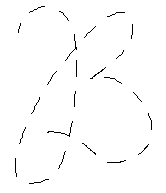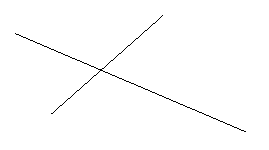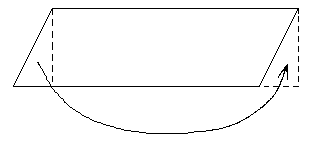C. George Boeree, PhD
Psychology Department
Shippensburg University
© Copyright C. George Boeree 2009
Perception
Perception - seeing, hearing, touching, smelling, tasting, feeling the positions of joints and the tension of muscles, balance, temperature, pain... - begins with the stimulation of sensory neurons. Each sense involves highly evolved cells which are sensitive to a particular stimulus: Pain receptors respond to certain chemicals produced when tissues are damaged; Touch receptors involve cells with hairs which, when bent, cause signals to travel down the cell's axon; Balance, movement, and even hearing involve similar hair cells; Temperature sensitive neurons have hairs that expand and contract in response to heat and cold; Taste and smell receptors respond to environmental molecules in the same way that other neurons respond to neurotransmitters; And the neurons of the retina respond to the presence of light or the specific frequency ranges of light we perceive as color.
But perception is more than just passive reception of information. Perception is an active process: Touch, for example, requires movement - something that nowadays we call "scanning." Touch includes information about you (e.g. your muscles, joints) as well as about what you are touching. We can say the same about hearing. We should really call it listening! The sound itself is intrinsically moving, of course - it is constantly changing. If it didn’t, we would stop hearing it!
And the same is true about vision. Vision involves constant movement - of our eyes, head, and body, or of the things we see or all of the above. The outer parts of our retina are particularly sensitive to motion - so when something comes into our field of vision, our attention is drawn to it. If we kept our eyes and the scene we are looking at perfectly still, everything would all become white!
We should also keep in mind that perception is not something done with the eyes or the ears or any specific sense organ. It is a multi-sensory, full bodied thing, totally involving: "A one-year-old child standing on the floor of a room will fall down if the walls are silently and suddenly moved forward a few inches, although nothing touches him." (Neisser, p. 116, referring to Lee and Aronson, 1974)
The "raw material" of perception
The perceptual process has a lot to work with from the very beginning: We are not in the position of having to make sense of a mosaic of meaningless dots of light or disconnected sounds or smells. Even as far back as the 1890's, William James pointed out that we not only perceive things but relationships such as "and" and "or" as well.
Take your hands and hold them up in front of you, separated by a few inches. You see your hands, of course, and it isn't hard to imagine that perceiving them is a matter of certain patterns of light followed by similar patterns of neural firings. But notice that you are also perceiving your hands as "next to each other," while in fact that perception is not directly presented to you as a stimulus in the way your hands themselves are.
Much of what we experience comes "pre-packaged," ready for our consumption. Nature provides "edges" - changes in light patterns, transitions of sounds - for us to use to pick objects out from their environment. For example, we see things as standing out from their background, something called the figure-ground phenomenon, introduced by the Danish phenomenologist Edgar Rubin (1886-1951).
The Danish psychologist Edgar Rubin demonstrated the phenomenon by
creating his classic example of
an
ambiguous figure-ground situation:

Basically, we perceive one aspect of an event as the figure and the other as the ground. In Rubin's figure, there is no true figure and ground. It is a drawing that pretends to be an object. We are forced by the ambiguity of it to use the shifting attention we give the vase or the faces to see one thing or the other.
Depth is a major example of something we experience directly, without the need for anticipatory interpretation. Traditionally, it has been assumed that we construct depth from such clues as perspective and relative size, as well as the slightly different images we get with binocular vision. But we only need to use such clues when we are looking at pictures that are faking depth! Actually, we see true depth because it is there to see.
Again, it is the fact that vision involves movement that shows us the truth of the matter. For example, things that are closer to us change position more quickly than things that are farther away, and distant objects form the backgrounds for the closer ones. Remember from childhood how the moon seemed to follow you as you drive along, while telephone poles whipped by at a million miles an hour?
Eleanor Gibson won her place in the history of psychology books with her visual cliff experiment. She built a special table: One half had plexiglass with a checkerboard pattern stuck beneath it. The other half also had plexiglass, but the checkerboard pattern was a couple of feet below, on the floor. In between was a board. Infants were then placed on the board, and their mothers were asked to coax them to crawl over one side or the other. Guess which side they didn't want to try? Apparently, babies are quite capable of seeing depth with very little, if any, experience with "cliffs."
Gestalts
The Gestalt psychologists (Max Wertheimer, Kurt Koffka, and Wolfgang Köhler) discovered many other ways in which what we perceive is already organized.
Gestalt psychology is based on the observation that we often experience things that are not a part of our simple sensations. The original observation was Wertheimer’s, when he noted that we perceive motion where there is nothing more than a rapid sequence of individual sensory events. This is what he saw in a toy stroboscope he bought at the Frankfurt train station, and what he saw in his laboratory when he experimented with lights flashing in rapid succession (like the Christmas lights that appear to course around the tree, or the fancy neon signs in Las Vegas that seem to move). The effect is called apparent motion, and it is actually the basic principle of motion pictures and television.
If we see what is not there, what is it that we are seeing? You could call it an illusion, but it's not an hallucination. Wetheimer explained that you are seeing an effect of the whole event, not contained in the sum of the parts. We see a coursing string of lights, even though only one light lights at a time, because the whole event contains relationships among the individual lights that we experience as well.
We are built to experience the structured whole as well as the individual sensations. That is what gestalt means: a structured whole. And not only do we have the ability to do so, we have a strong tendency to do so. We even add structure to events which do not have gestalt structural qualities.
In perception, there are many organizing principles called gestalt laws. The most general is called the law of pragnanz. Pragnanz is German for pregnant, but in the sense of pregnant with meaning, rather than pregnant with child. This law says that we are innately driven to experience things in as good a gestalt as possible. “Good” can mean many things here, such regularity, orderliness, simplicity, symmetry, and so on, which then refer to specific gestalt laws.
For example, a set of dots outlining the shape of a star is likely to be perceived as a star, not as a set of dots. We tend to complete the figure, make it the way it “should” be, finish it. Like we somehow manage to see this as a "B"...

The law of closure says that, if something is missing in an otherwise complete figure, we will tend to add it. A triangle, for example, with a small part of its edge missing, will still be seen as a triangle. We will “close” the gap.
The law of similarity says that we will tend to group similar items together, to see them as forming a gestalt, within a larger form. Here is a simple typographic example:
OXXXXXXXXXX
XOXXXXXXXXX
XXOXXXXXXXX
XXXOXXXXXXX
XXXXOXXXXXX
XXXXXOXXXXX
XXXXXXOXXXX
XXXXXXXOXXX
XXXXXXXXOXX
XXXXXXXXXOX
XXXXXXXXXXO
It is just natural for us to see the o’s as a line within a field of x’s.
Another law is the law of proximity. Things that are close together as seen as belonging together. For example...
**************
**************
**************
You are much more likely to see three lines of close-together *’s than 14 vertical collections of 3 *’s each.
Next, there’s the law of symmetry. Take a look at this example:
[ ][ ][ ]
Despite the pressure of proximity to group the brackets nearest each other together, symmetry overwhelms our perception and makes us see them as pairs of symmetrical brackets.
Another law is the law of continuity. When we can see a line, for example, as continuing through another line, rather than stopping and starting, we will do so, as in this example, which we see as composed of two lines, not as a combination of two angles...:

The gestalt psychologists also pointed out that, when we see a duck and an elephant, there is little in their natures that would cause us to perceive them as belonging together. But if they are both walking together in the same direction across a field, their common path is immediately perceived as a connection between them.
But the gestalt principles are by no means restricted to perception - that’s just where they were first noticed. Take, for example, memory. That too seems to work by these laws. If you see an irregular figure, such as a badly written name, it is likely that your memory will straighten it out for you a bit. Or, if you experience something that doesn’t quite make sense to you, you will tend to remember it as having meaning that may not have been there. A good example is dreams: Watch yourself the next time you tell someone a dream and see if you don’t notice yourself modifying the dream a little to force it to make sense!
Gestalt theory is well known for its concept of insight learning. People tend to misunderstand what is being suggested here: The Gestalt psychologists are not so much talking about flashes of intuition, but rather solving a problem by means of the recognition of a gestalt or organizing principle.
The most famous example of insight learning involved a chimp named Sultan. He was presented with many different practical problems (most involving getting a hard-to-reach banana). When, for example, he had been allowed to play with sticks that could be put together like a fishing pole, he appeared to consider in a very human fashion the situation of the out-of-reach banana thoughtfully - and then rather suddenly jump up, assemble the poles, and reach the banana.
A similar example involved a five year old girl, presented with a geometry problem way over her head: How do you figure the area of a parallelogram? She considered, then excitedly asked for a pair of scissors. She cut off a triangle from one end, and moved it around to the other side, turning the parallelogram into a simple rectangle. Wertheimer called this productive thinking.

The perception of utility
Many psychologists, including phenomenologists and Gestalt psychologists, talk about the direct perception of the use of objects. Some things "afford various possibilities for action, carry implications about what has happened or will happen, belong coherently to a larger context, possess an identity that transcends their simple physical properties." (Neisser, p. 71)
Rubin called it utility determination: "We see immediately that a hammer is meant for hammering, a pencil for writing, a pipe for smoking." (From, p. 15) Koffka called this demand character: "Each thing says what it is...a fruit says 'Eat me;' water says 'Drink me;' thunder says 'Fear me...'" (Koffka, p. 7)
J.J. Gibson calls them affordances: "The affordances of the environment are what it offers the animal, what it provides or furnishes, either for good or ill.... the 'values' and 'meanings' of things in the environment can be directly perceived." (Gibson, p. 127)
"An elongated object of moderate size and weight affords wielding. If used to hit or strike, it is a club or hammer. If used by a chimpanzee behind bars to pull in a banana beyond its reach, it is a sort of rake. In either case, it is an extension of the arm. A rigid staff also affords leverage and that use is a lever. A pointed elongated object affords piercing -- if large it is a spear, if small a needle or awl." (Gibson p. 128)
And likewise for objects that afford cutting (knives) or throwing (balls) or binding (rope) or "trace making" (a pen, brush, pencil...).
"The different places of a habitat may have different affordances. Some are places where food is usually found and others where it is not. There are places of danger, such as the brink of a cliff and the regions where predators lurk. There are places of refuge from predators. Among these is the place where mate and young are, the home, which is usually a partial enclosure. Animals are skilled at what the psychologist calles place-learning. They can find their way to significant places." (Gibson, p. 136)
"The medium, substances, surfaces, places, and other animals have affordances for a given animal. They offer benefit or injury, life or death. This is why they need to be perceived." (Gibson, p. 143)
"The different substances of the environment have different affordances for nutrition and for manufacture. The different objects of the environment have different affordances for manipulation. The other animals afford, above all, a rich and complex set of interactions, sexual, predatory, nurturing, fighting, playing, cooperating, and communicating. What other persons afford, comprises the whole realm of social significance for human beings." (Gibson, p. 128)